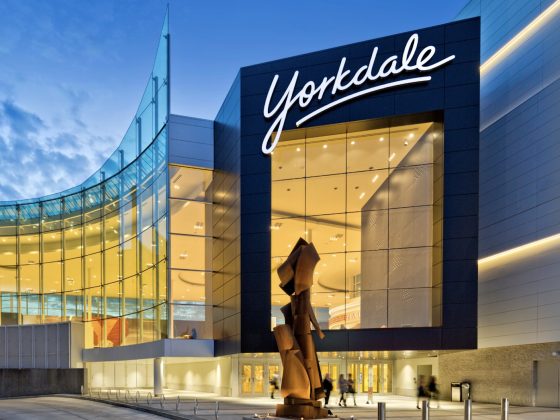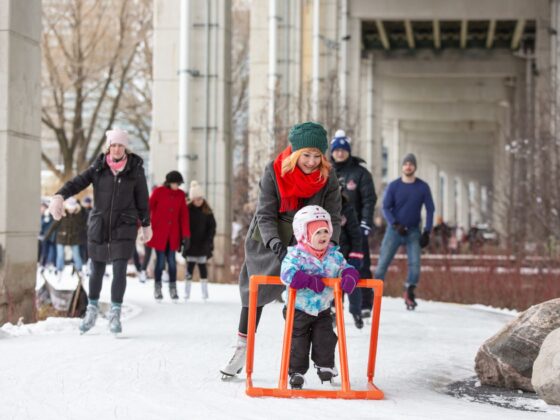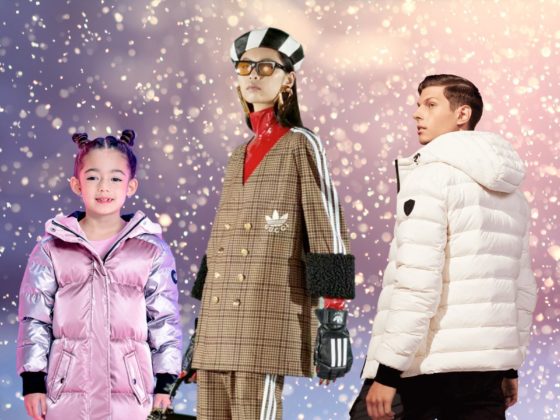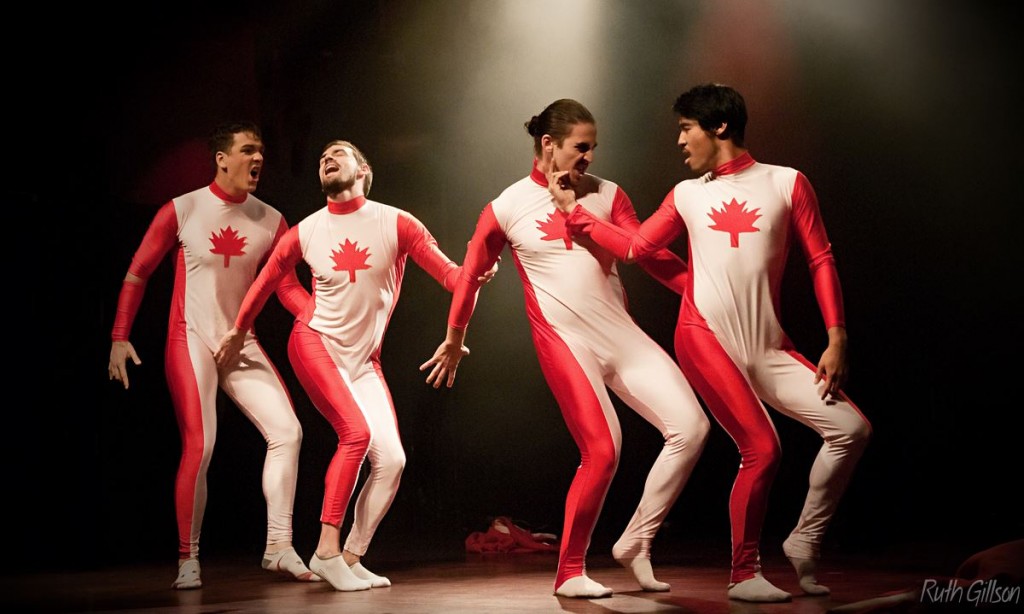
We sent Vv Magazine’s Neelam Champaneri to meet Boylesque TO, Canada’s first all-male burlesque troupe, in light of their Canuck-themed “Oh Manada” show on June 30 at Lee’s Palace.
“What’s the verb for cunnilingus? To cunnaling?” asks Dew Lily, followed by Mike chanting “cunnilinginging” before the rehearsal for Boylesque TO’s Oh Manada show. Boylesque TO is Canada’s premier all-male Burlesque troupe hailing from Toronto and led by Benjamin Paley, who is better know by his stage name, James and the Giant Pasty.
It’s 8:30 p.m. on a Tuesday night, and 15 people cram a rehearsal room, plus two cats roaming freely. Nerves linger in the air as the summer heat turns to an evening chill. It’s time to practice.
ADVERTISEMENT |
The instrumental version of American Boy by Estelle and Kanye West plays, and Pasty, who asks what the cue was, interrupts Ginger Darling’s rehearsal. He then quickly calls for the other boys to show them the dance moves. “Left crossover, right. Left crossover, right. Order does not matter.”
The word burlesque typically evokes images of half-naked women dancing cabaret to erotic, upbeat music before an audience of horny men. Boylesque is similar but also radically different: the Toronto troupe not only entertains with cheeky tassels and tasteful nudity, they also hope to challenge the way we think of gender fluidity and male sexuality.
Burlesque is a genre of theatre composed of vaudeville, comedy and dance. A key element is nudity, which has been paired with burlesque as early as 1900. Female performers would strip before the audience, but keep their lady bits hidden.
As the name suggests, Boylesque is the male version. A male burlesque performer from New York named Tigger, who’s been in the industry for 20 years, coined this term. “He’s the reason there’s a male category at the burlesque hall of fame,” mentioned Sebastian Rodriguez, otherwise know as El Toro, another member of the troupe.
ADVERTISEMENT |
After rehearsal, Pasty, El Toro, and myself are seated at The Lakeview on Dundas, drinking pints of King Pilsner. My first question was obvious: “What made you want to start Boylesque TO?”

Paley’s interest began at 15. “I just loved the celebration of nudity and different body types, different sexualities … but also just the theatricality of it,” says Pasty. As he got older, he realized something was missing. There were no men.
According to Paley, back in 2008, about 1 in 100 burlesque performers was male, and there were no all-male troupes. “I wanted to do burlesque in some way and I think the idea of doing it on my own was terrifying. It was easier for me to think of starting a group than doing it with people collectively.”
Knowing only one person in the burlesque community and looking for more connections, he emailed a female advice columnist for help. “I felt like, you’re only getting half the story with only one gender, and only half the possible expression of all sexuality and body types … She responded in such a horrible way, she just assumed I was a gay boy trying to see other gay boys in their underwear.” Not cool, woman.
The let-down didn’t stop him. His passion led him to establishing the troupe in 2008.
ADVERTISEMENT |
Boylesque TO contains four or five core performers, and the rest rotate. A change in the line-up also affects the dynamic of the group. Pasty believes it’s important to bring in guys who have the right fit. But artistic inspiration is key; this helps set them apart from other troupes.
“Every troupe is going to have their own flavour. Some are gonna lead more towards heavy choreography, or sex appeal, theatricality, comedy. I think we really try to put together deeply themed, theatrical shows instead of your regular old cabaret full of acts.”
“It’s very satirical and political,” adds El Toro.
ADVERTISEMENT |
Their hard work has certainly paid off. Having been featured in various magazines and getting the opportunity to travel around the world, these guys have branded themselves in the world of burlesque. “I think we do a really cool thing, and it’s wonderful that people appreciate what we do and are interested in it,” Paley says.
Gender performance, fluidity and sex positivity are some things that these guys promote in their shows; they challenge male stereotypes in every single way. It’s intriguing to see a group of men, each identifying with a different sexual orientation, push the envelope. “When I’m on stage, my sexuality can be ambiguous and fluid so that both men and women can enjoy the performance,” says Pasty.
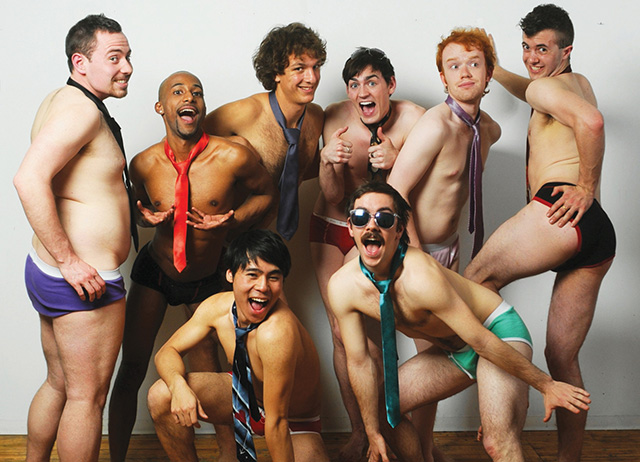
“When people ask me if I’m gay or straight, I just say that I’m a whole lot of things because I don’t like giving a straight answer,” El Toro mentions with a giggle.
ADVERTISEMENT |
Boylesque also provides a gentle reminder that everything is merely a performance once you’re on stage. When people think of male sexuality, they often think of heteronormative masculinity. Boylesque plays off of this. “Ultimately as a burlesque performer you’re working, at some degree, with archetypes and traditional characters that are sexualized, like James Bond or a fireman,” says Pasty. “We subvert the macho and fuck with it.”
The biggest difference between a male performing a male role and a male performing a fluid role is the presence of a story within the character. “The whole point is that you can be anything and everything. There’s no binary gender when it comes to what we do,” El Toro states as he tips down the last of his second brew.
Boylesque is set to perform Oh Manada, their signature Canuck-flavoured show, on Tuesday June 30th at Lee’s Palace. Expect a twist on Canadian cult archetypes and the sexualization of stuff that hasn’t been sexualized.
ADVERTISEMENT |
Related Link: Toronto Pride 2015, your ultimate party guide
What are your thoughts on Boylesque? Let Vv Magazine know in the comments below, or tweet us @ViewtheVibe.



